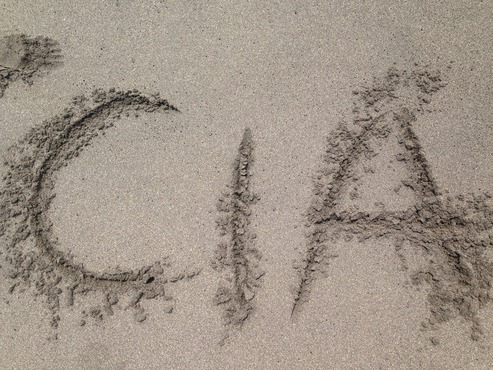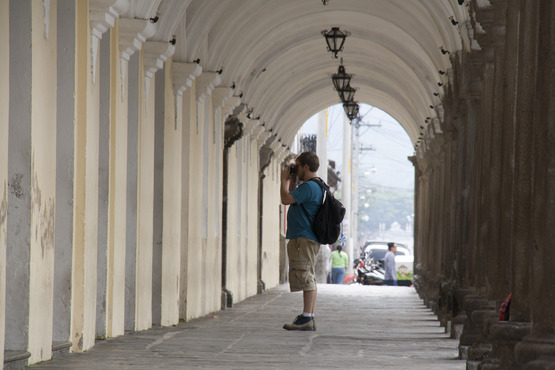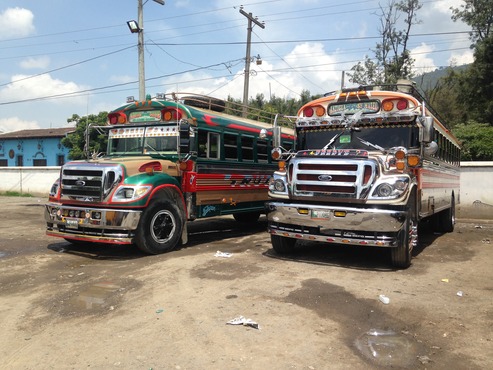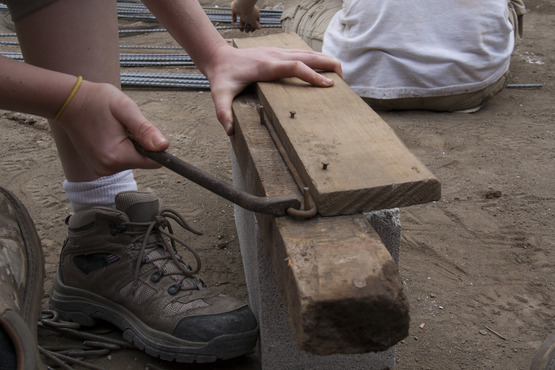
Blog . Final Weekend Report from Guatemala
Blog
Final Weekend Report from Guatemala
06/02/14 | Posted by | Posted in Students in the Community
Hi, everyone. Max Beers in Guatemala, here. Here are some further reflections I want to share, followed by a description of our final weekend’s cultural activities:
Q: Describe your "typical" weekday (work day) in Guatemala.
My typical weekday includes waking up around 7:15 am to the smell of fresh fruit, fresh eggs, and cereal. Around 8:10, we head out to our driver that picks us up on our street at 8:15 (although we have also been exploring the chicken buses that we intend to use for the rest of our trip). We catch the chicken bus at the same time in the morning, in the Market. It costs around 4Q (~50 cents US) for a half hour commute, compared to the personal driver generously provided through Constru Casa that has been 25Q per person (~$3.25 US), just to cover gas - and both of which are significantly less expensive than a "shuttle." We start our commute either in the personal carload, or on the packed chicken bus. The streets in Antigua are cobblestone until we get out on to the highway, which is paved and in excellent condition (different than Cleveland!). Motorcycles and all sorts of vehicles zoom past on the left. On each side of the highway are volcanoes and mountains, with aromas from fruit trucks driving in front of us. When we get close to the job site, we take a hard left to an unmarked village full of happy hopeful people and full of unstable sheet metal shacks with dirt floors. We get right to work and Oscar, the head mason and our supervisor, gives us a task such as axing holes in brick or bending rebar. We work till around 12 pm and take an hour lunch, right next to the masons, who always say a prayer before eating their lunch, even if it's a simple bowl of noodles. We again work hard through 4 pm, walk to the chicken bus station, and wait till our bus, “Esmeralda,” comes and picks us up. When we reach Antigua, we trudge back to our home-stay, where we typically shower and relax until 7, when Anabella, our home-stay mom, makes dinner. After dinner we go get ice cream or stop at a local coffee shop. Around 10 pm our bodies shut down due to the hard work, and in the morning we start all over again.
Q: Describe what you think a typical day might be like for the recipient family.
Guermo and his wife, Gloria, and their teenaged son, Guermo Jr., have a pretty modest and hard working life style. Mornings would start early for Gloria, making breakfast for her family which probably consists of fresh eggs on a small gas stove, bread, and fresh fruit. After this, she goes off to her job in town (Antigua) by chicken bus. Midday, Guermo Jr. would head off to school, nicely dressed, and come home a few hours later. Around the same time as his son, Guermo would depart with his trumpet by chicken bus. All of them would get lunch while out, or probably skip lunch altogether. By 7 pm (already dark by then), all three of them would meet at the kitchen table and share a meal together, with very minimal electricity and lighting.
Q: How has this trip and experience challenged your previous assumptions and stereotypes about the community of people you have been serving, for example, assumptions and stereotypes about their difficulties, values, belief systems, ambitions, daily way of life, or approach to life, etc.?
Generally I only had assumptions about the community I was going to be serving. Some of these assumptions were that they might not like Americans, had poor shelter, and ate strange food. All of these were proven inaccurate. The Guatemalan people that I have met in the village of San Miguel Duenas are more than welcoming, have little to no shelter, and their food is miraculous. Also upon my arrival here, I was surprised how healthy they eat, all fresh and home-prepared food. Their presentation of themselves is extremely important – this means no yoga pants to say the least, and long pants and dress shirts are mandatory. Another impressive observation is that people are not glued to their cell phones. They make necessary phone calls, check the time for lunch, and that is it. (I have seen no cell phones among the people in the village of San Miguel Duenas, so this last observation applies only to the masons who come into the village to construct the homes.)
Q: How is it possible to go into another country, in order to provide a service to a community or family "in need," and still maintain a relationship of mutual respect, mutual exchange of value with one another, and equitable "power"?
It is possible! One of the things I did notice is that waving around your electronics, or being flashy in general, does not help. (This is one reason my faculty supervisor and I decided to equip the trip with small, inexpensive “handy cams,” instead of larger, more professional equipment.) Also, after just a consistent amount of days volunteering, more and more villagers warm up to you and introduce themselves. Just doing hard work alongside one another, and making a joke once in while, made us equals by the end of the first week. Guermo began calling us “amigos,” which means a lot. By becoming one of the community, I was no longer making a video of the Kent State students helping to build a house, but instead a video of a couple amigos building a house for a neighbor in need. Seeing the roof being put on, and all the neighbors peaking their heads out of their own dwellings to see this final touch, was a beautiful thing.
Weekend cultural activity:
This past Friday, May 30, my remaining Kent State colleague, Dustan, and I decided to travel overnight to Monterrico, Guatemala, which is on the SW coast of Guatemala on the Pacific Ocean. With the weekend ahead of us, we decided to be courageous and take a “chicken bus” there. We found the chicken bus station in Antigua, and roamed around for a while until one man started yelling “Escuintla!! Escuintla!!” (The chicken buses have no destination signage.) We got on this packed bus with two seats left! Once we got on the highway, they collected our 8Q ($1.02 US!), and what was supposed to be a 1-hour bus trip turned into two. Then we arrived at a grungy remote bus station enroute, and we knew we were not in Antigua anymore. There, we boarded the Monterrico bus for 25Q ($3.25!). By then, the heat and cramped ride made the sweat pour, and once again a 1-hour trip turned into 2 hours due to all the random stops along the highway. When after 4 hours on chicken buses, we finally arrived in Monterrico, we were surprised to be two of the only American tourists, due to the rainy season! We got lost for a good half-hour until finally finding our hotel, Johnny’s Place. For an incredibly few Quetzals, the hotel offered a beautiful pool, an ocean view, and wonderful food available anytime. Dustan and I hung out in the powerful ocean and relaxing pool till 4 pm on Saturday, and then got a more relaxing "shuttle" home to Antigua. Sunday was a rest day at the home-stay, including blog writing and continuing organization of photo/video documentation. Monday is my last day on the job site, and Tuesday I depart for Cleveland already! Please keep an eye out for one more blog post while I’m on the ground here!
-
Comments
1

- Tweet
Ann McGuire
9 years ago
Thanks for these updates, Max. You've approached this project with an admirable combination of humility and curiosity and you've done a great job of sharing your stories.















